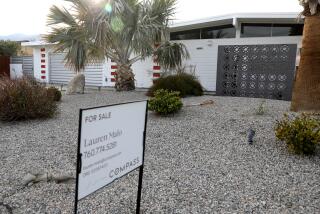Software Revolutionizing Client-Information Systems : Database: The program devised by two San Diegans may make the customer index card obsolete.
- Share via
When Bill Berkley and Tim Creagh were introduced to each other through their wives a few years ago, the two San Diegans thought that they had little in common. At first glance, Berkley, a commercial real estate broker, and Creagh, a tennis instructor, seemed an unlikely pair to become business partners.
But that’s exactly what happened.
In 1987, the two founded Creagh Computer Systems of Solana Beach, a manufacturer of database software that allows users to custom-design how they store information to better monitor client and account activity. The database’s “filing cabinet” function gives the user the ability to produce everything from mailing lists to client profiles.
The private company’s first product, Real Estate Assistant--a database program designed for real estate brokers--has become a popular business tool at firms such as Coldwell Banker, Grubb & Ellis, and Iliff, Thorn & Co. In 1989, Creagh Computer Systems posted pretax profits of more than $110,000 based on revenues of $850,000.
Creagh Computer Systems has also recorded early success with Biz-Base, its “generic industry” database program, said Berkley, 45, the company’s chief executive officer. During the first three months after product introduction in December, 1989, Creagh Computer Systems sold 1,855 Biz-Base packages to customers, including to corporations such as General Motors, Xerox, Chrysler and General Electric.
When Berkley discovered that Creagh, 37, had successfully developed a database program to boost membership at his tennis club, he envisioned using a similar software program to enhance his own business. Creagh used his combined database and word-processing program to log the residents who lived near the tennis club and then dispatched letters to them promoting the facility.
At a time when most brokers were jotting client information on index cards, Berkley had a hunch that a sophisticated information storage system that would allow him to monitor clients and track available properties would keep him one step ahead of his competitors.
“I had begun developing a database program myself . . . one that would include properties for sale, all the different buyers and what they were looking for, and all the different properties in San Diego valued above a certain price,” Berkley said. “In 1983, (Creagh) came into my office because he was interested in selling commercial real estate. In the process, he saw the database that I was working on and told me he could improve upon it.
“That was the understatement of the decade.”
Creagh, now the company’s chairman, added a word processor to the software and other features that allow the user to simultaneously produce marketing letters to potential clients. The database also records all letters and phone calls made to a particular client and stores it on a client file. The program even reminds the user to make a follow-up call after mailing of a first letter.
Larry O’Harra, vice president and manager of Iliff, Thorn & Co.’s Carlsbad office, says the database program has helped bring the real estate industry into the Information Age.
“We were developing our own software system because we knew we would need it to stay competitive,” O’Harra said. “When we saw the Real Estate Assistant program, we realized that that was exactly what we wanted.” The Phoenix-based real estate firm has made REA its database standard.
O’Harra says the database provides brokers immediate access to information about a client or a specific property. O’Harra recalled an incident when one of his brokers received a call from an apartment investor.
“It was a call out of the blue in response to one of our ads,” O’Harra said. “The caller identified himself as Mr. So-and-So who owned some apartment units in San Marcos. The broker typed in his name and the location of apartments he owned, and instantly he knew that the caller owned 42 units in San Marcos, 12 in Chula Vista and some other properties.
“Not only was the caller flattered by the fact that we knew so much about him, it helped us determine whether he’s a legitimate investor,” O’Harra said. “Hit a few more keys and we had a letter ready to go to (the caller) about the apartments he was interested in. The database reduces the turn-around time to get back to the client.”
Since the REA database package was introduced 18 months ago, Creagh Computer Systems has sold 983 kits, each package costing $629.
More to Read
Inside the business of entertainment
The Wide Shot brings you news, analysis and insights on everything from streaming wars to production — and what it all means for the future.
You may occasionally receive promotional content from the Los Angeles Times.










